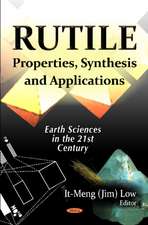Deformation Processes in Minerals, Ceramics and Rocks: The Mineralogical Society Series, cartea 1
Autor D.J. Barber, P.G. Meredithen Limba Engleză Paperback – 7 mar 2012
Preț: 396.62 lei
Nou
Puncte Express: 595
Preț estimativ în valută:
75.89€ • 79.40$ • 63.04£
75.89€ • 79.40$ • 63.04£
Carte tipărită la comandă
Livrare economică 03-17 aprilie
Preluare comenzi: 021 569.72.76
Specificații
ISBN-13: 9789401168298
ISBN-10: 9401168296
Pagini: 444
Ilustrații: XVIII, 424 p.
Dimensiuni: 155 x 235 x 30 mm
Greutate: 0.62 kg
Ediția:Softcover reprint of the original 1st ed. 1990
Editura: SPRINGER NETHERLANDS
Colecția Springer
Seria The Mineralogical Society Series
Locul publicării:Dordrecht, Netherlands
ISBN-10: 9401168296
Pagini: 444
Ilustrații: XVIII, 424 p.
Dimensiuni: 155 x 235 x 30 mm
Greutate: 0.62 kg
Ediția:Softcover reprint of the original 1st ed. 1990
Editura: SPRINGER NETHERLANDS
Colecția Springer
Seria The Mineralogical Society Series
Locul publicării:Dordrecht, Netherlands
Public țintă
ResearchCuprins
An introduction.- References.- 1 Fracture and failure of brittle polycrystals: an overview.- 1.1 Introduction.- 1.2 Linear elastic fracture mechanics (LEFM).- 1.3 Quasi-static fracture and failure.- 1.4 Inelastic fracture processes.- 1.5 Fracture and failure prediction.- 1.6 Indirect monitoring of fracture.- 1.7 Concluding remarks.- Acknowledgements.- References.- 2 Single-crack behaviour and crack statistics.- 2.1 Introduction.- 2.2 Single-crack behaviour.- 2.3 Multiple-crack behaviour.- 2.4 Crack statistics: percolation models.- 2.5 Conclusions.- References.- 3 Fracture of polycrystalline ceramics.- 3.1 Introduction.- 3.2 Flaw size/grain size effects.- 3.3 Toughening mechanisms.- 3.4 Environmental effects.- 3.5 Implications of crack-interface tractions on failure predictions.- 3.6 Concluding remarks.- References.- 4 Compressive brittle fracture and the construction of multiaxial failure maps.- 4.1 Introduction.- 4.2 The isolated crack in an infinite plate.- 4.3 Crack interaction.- 4.4 Multi-axial failure maps.- 4.5 Summary and conclusions.- Acknowledgements.- References.- 5 Brittle-to-ductile transitions in polycrystalline non-metallic materials.- 5.1 Introduction.- 5.2 Effect of temperature (T) and strain rate ($${\dot \varepsilon }$$) on plastic flow and brittle cleavage.- 5.3 Effect of tension, compression, and confining pressure (stress triaxiality) on plastic flow and brittle cleavage.- 5.4 Transition from fracture to plastic flow.- 5.5 Discussion and conclusions.- References.- 6 Régimes of plastic deformation — processes and microstructures: an overview.- 6.1 Introduction.- 6.2 The phenomenology of creep.- 6.3 Creep mechanisms.- 6.4 The classification of deformation régimes and mechanical properties.- 6.5 The structure of grain boundaries and interfacesbetween phases, and the nature of intergranular films.- 6.6 Microstructures, preferred orientation, and models of crystalline plasticity.- 6.7 Concluding remarks.- Acknowledgements.- References.- 7 Experimental deformation and data processing.- 7.1 Introduction.- 7.2 The traditional methods.- 7.3 A global inversion method.- 7.4 An example of creep data processing.- 7.5 Conclusion.- Acknowledgements.- References.- 8 Experimental studies of deformation mechanisms and microstructure in quartzo-feldspathic rocks.- 8.1 Introduction.- 8.2 Experimental techniques.- 8.3 Experimental deformation of quartz aggregates.- 8.4 Experimental deformation of feldspar aggregates.- 8.5 Experimental deformation of quartzo-feldspathic aggregates.- 8.6 Summary.- Acknowledgements.- References.- 9 Microstructural analysis and tectonic evolution in thrust systems: examples from the Assynt region of the Moine Thrust Zone, north-west Scotland.- 9.1 Introduction.- 9.2 Deformation histories in thrust systems.- 9.3 The Moine Thrust Zone of north-west Scotland.- 9.4 The Moine Thrust at the Stack of Glencoul.- 9.5 The Assynt Thrust sheet.- 9.6 The Sole Thrust System.- 9.7 Discussion.- 9.8 Conclusions.- Acknowledgements.- References.- 10 Mechanisms of reaction-enhanced deformability in minerals and rocks.- 10.1 Introduction.- 10.2 Experimental data.- 10.3 Field and petrographic data.- 10.4 Deformation mechanisms.- 10.5 Conclusions.- Acknowledgements.- References.- 11 Thermodynamics of rock deformation by pressure solution.- 11.1 Introduction.- 11.2 Microscale continuum theory of constituent behaviour.- 11.3 Thermodynamic framework for a macroscale theory of aggregate behaviour.- 11.4 Intergranular pressure solution as a stationary non-equilibrium process.- 11.5 Concluding summary.- Acknowledgements.- References.- 12 Densification of crystalline aggregates by fluid-phase diffusional creep.- 12.1 Introduction.- 12.2 The model.- 12.3 Experiments on sodium chloride.- 12.4 Discussion.- 12.5 Summary.- Acknowledgements.- References.- 13 Dynamic recrystallization and grain size.- 13.1 Introduction.- 13.2 Dynamic recrystallization by migration: mechanisms and models.- 13.3 Microstructural measurements as a function of stress.- References.- 14 Simulation of dislocation-assisted plastic deformation in olivine polycrystals.- 14.1 Introduction.- 14.2 Slip systems.- 14.3 Texture predictions from Taylor theory.- 14.4 Texture predictions from self-consistent theory.- 14.5 Discussion.- Acknowledgements.- References.- 15 On the slip systems in uranium dioxide.- 15.1 Introduction.- 15.2 Effects of non-stoichiometry on microhardness, flow stress, and preferred slip system.- 15.3 The structure of half-slipped dislocations.- 15.4 Questions for future work.- Acknowledgement.- References.- 16 A TEM study of dislocation reactions in experimentally deformed chalcopyrite single crystals.- 16.1 Introduction.- 16.2 Dislocation reactions in crystals strained at 200°C.- 16.3 Dislocation reactions in crystals strained at 400°C.- 16.4 Discussion.- 16.5 Summary and conclusions.- Acknowledgements.- References.
















